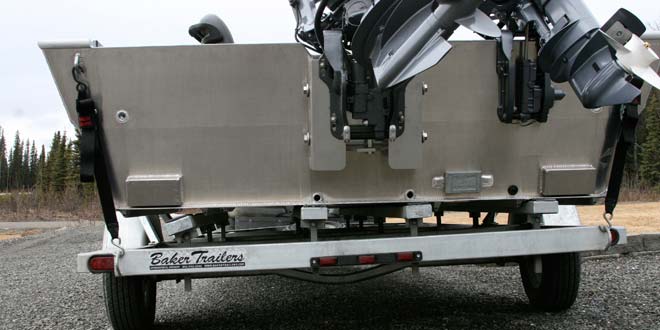
How to Properly Store your Boat
It is a sad day. The ocean is rough, the rivers are dropping fast, the banks are iced over and the snow is falling. For all but the insanely hardcore Alaska angler, it is time to store your boat and curl up by the fire.
As a professional fishing guide, I rely on my equipment to perform flawlessly each and every day. So do the clients that are paying me a substantial fee. For these reasons, I keep my boats in tip-top shape, functioning correctly and clean at all times. Many fellow guides rib me about this. Contrary to popular opinion in my area, I am not obsessive/compulsive nor am I a workaholic. In actuality, I am a relatively lazy person, to the point where I find ways to ensure that I don’t have to work any harder than absolutely necessary. Which is exactly why I force myself each fall to dedicate one full day to properly storing my boats for the winter.
I’ve found that a little hardship now guards against a lot of hardship (and work) next spring. It’s trite, but a little maintenance goes a long way. After all, who wants to work on a boat when the weather is nice, the fish are in and it is finally time to hit the water?
At this point in the discussion, I am going to assume that you are a boat owner, who, like me, does not have the luxury of a large, heated garage for storage. I finally have a four-stall carport for my boats but it is neither enclosed nor heated.
For decades, my boats were stored outside; tented and tarped with a rough but effective makeshift cover to guard against our heavy snow load. Obviously, boats stored inside can bypass some of the following recommendations.
There are several considerations and decisions you need to make when dealing with the power plant and fuel in your boat. The first is whether to store your gas tank empty or full. There are different schools of thought here and both have their pros and cons. If you store the tank empty, you run the risk of fuel-vapor ignition, obviously not a good thing. More likely to occur though is condensation on the internal walls of your gas tank, a phenomenon that happens with fluctuations in temperature. However, if you store the tank full, a new concern rises: phase separation between the gas and ethanol begins after about 90 days, which creates a sludge-like gel that increases the chance of your motor running poorly (or not at all) in the spring.
The answer? Store the tank full of new, high-quality fuel and treat it with a good fuel conditioner and stabilizer like Sta-Bil. After treating your fuel with the recommended amount, drain or replace the water-separator fuel filter and run your motor for at least five minutes, ensuring that the new, treated gas passes through your filters, lines, carbs or EFI system. If you still run a two-stroke motor, you might consider purchasing some fogging spray and fogging your carbs while the motor is running. These measures ensure that sludge buildup is eliminated, cylinder walls and seals are protected and everything works as it should six or seven months from now.
While we are on the topic of motors, a few more measures must take place to ensure that damage from freezing does not occur.
First and foremost, you need to change the lube in the lower unit. Seals often go bad (for numerous reasons, such as line in the prop or propeller impact with rocks, gravel or debris), allowing water to enter your previously sealed gear case. This obviously degrades the lubricating quality of your gear oil, but it also creates the potential for your lower-unit case to crack once freezing temps arrive, a costly repair that can easily be avoided. Pull the prop, check for fishing line and inspect the prop shaft and seal for visible damage. Then drain your lower-unit lube, inspecting for metal shavings or a telltale milky mustard color, a clear indicator that water has entered. If the lube is dirty but otherwise good, continue draining and refill to the recommended level. If it is the aforementioned condition, contact your boat mechanic at once to find and repair the source of the contaminating water.
I then replace my spark plugs and change my oil and filter; it makes no sense to let sludgy, degraded oil remain in the motor you rely on all summer. In this way, my outboards are not only prepared for a deep winter sleep, but they are also fully ready to run next spring.
With all fluids, lubes and filters changed, I now run my outboard for a few minutes to make sure that all internal parts are properly coated with new lube and that the motor is running (and peeing water) well. Now disconnect the fuel line and run the motor until it dies, but only if it is a carbureted two stroke. If it is a modern four-stroke with EFI, do not run it out of gas, as it can be difficult to prime the fuel injection the next time you attempt to start it.
I then wash my boat thoroughly inside and out, as I like to put it away clean. I run a solution of Simple Green under the floorboards and thru the bilge pump before removing the drain plug. This cleans and guards against foul odors created by old fish blood and bait goo. If your boat has a wash-down pump, run some RV antifreeze thru the system and then disconnect all lines; otherwise it will freeze and crack, whereas you will have to replace it in the spring. It only took me three years to figure this out!
I always go through all the hatches, compartments and seat boxes, removing any item that might not fair well during exposure to prolonged lengths of deep freeze. This includes, but is not limited to, aerosol cans like WD40, scents and oils, fire extinguishers, compressed air horns and sonar screens (transducers seem to fare fine). Remove your battery and store in a warm garage on a wooden board to guard against the drainage of power. I also remove my lifejackets and throwable devices, hanging them in a warm, dry location to air out and prevent mildew that often occurs in damp hatches and seat boxes.
Don’t forget your trailer, as it needs periodic maintenance, too. Now is a great time to inspect lights, replacing electrical plug-ins or bulbs (if needed). Check tires for uneven wear or low pressure. Lube your wheel bearings as well as your hitch and dolly wheel assembly to prevent rust and salt corrosion.
As a final detail, always store your outboard in the down position so that any rain or residual water in and around the lower unit can effectively drain. Cover your boat, kiss it goodnight and walk away. You will be amazed at how well it treats you the following spring and summer!


